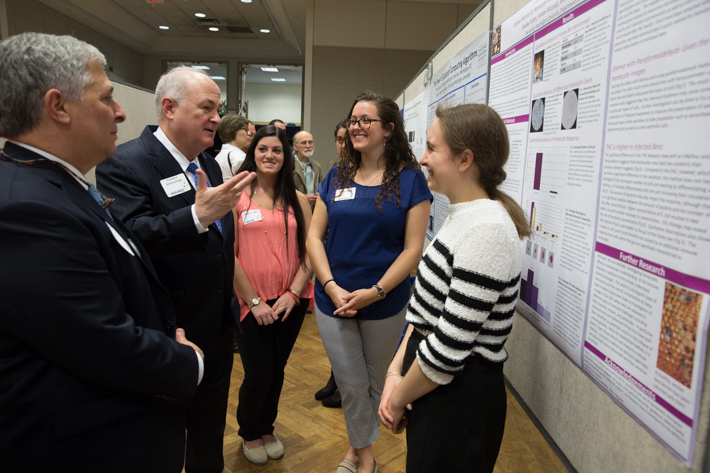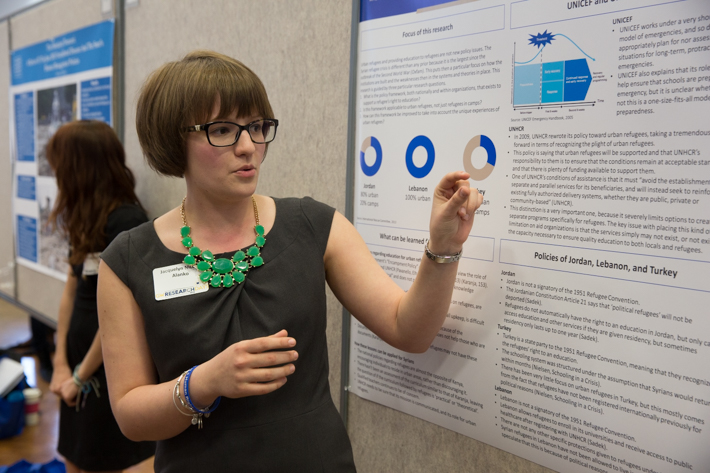As a freshman-year beekeeper at the George Washington University Bee Laboratory, Ricky Zhu grew to love the fuzzy insects that buzz in hives on Lisner Hall’s rooftop.
“They’re more peaceful than one might think,” said Mr. Zhu, now a senior majoring in biology in the Columbian College of Arts and Sciences. “People often think of bees as stingers. I think of them as pets.”
But during his junior year at GW, Mr. Zhu switched his role from beekeeper to researcher. He was intent on investigating a question that has mystified ecologists for more than a decade: What’s happening to the honeybees?
“I wanted to unearth answers about why there are so little bees left in the hive,” he said.
Mr. Zhu is one of several undergraduate researchers working with Biology Professor Hartmut Doebel to figure out why bees around the world are dying at alarming rates, a phenomenon called colony collapse disorder.
An animated Mr. Zhu talked eagerly about his research project—uncovering whether a class of pesticides are poisoning honeybee hives—during the 20th annual GW Research Days.
He was among the 191 undergraduate and graduate students who filled the third floor of the Marvin Center Tuesday to showcase their work to students, faculty, staff and judges. The first of the two-day event—which featured poster presentations from the arts, business, engineering, humanities, law and science fields—saw a 15 percent increase in student participants from 2014.
Medical, nursing, public health and biomedical engineering students will showcase more than 280 projects Wednesday, day two of Research Days. The day will include presentations from Philip E. Bourne, associate director for Data Science at the National Institutes of Health, and NIH Chief and Senior Investigator Julie Segre in Lisner Auditorium. Representatives from scientific equipment vendors—including FEI, Keysight Technologies and PerkinElmer—also visited the Marvin Center Tuesday, giving equipment demonstrations and talking with student researchers.
“We’ve never turned anyone away before, but there is barely enough space this year. That’s a good problem to have,” said Tom Russo, GW’s assistant vice president for corporate and industry research.
He attributed much of the event’s growth to new research faculty members whom the university has hired in the past five years.
“They’re really stimulating their students,” he said. “The caliber of the student research and the professionalism in their posters has noticeably improved from previous years.”
After a loop around the student posters and chatting with students, George Washington President Steven Knapp agreed that this year’s group of posters represented some of the most sophisticated and diverse projects he has seen.
“Giving students the opportunity to work with faculty who are at the forefront of their fields is one of the most exciting ways they can learn. That’s why we’ve been supporting this program, and I think it’s only going to continue to grow,” Dr. Knapp said. “The word has spread.”

(Far right) Brooke Talbot, a senior in the Columbian College of Arts and Sciences, talks about her research project to President Steven Knapp. Ms. Talbot is studying whether a bacterial infection triggers differentiation in worker bees. (William Atkins/GW Today)
Day-one projects ranged from Samuel Klein’s investigation of China’s military strategy in cyberspace to Katherine Bradshaw’s study of female roles in three versions of Shakespeare’s “Coriolanus.”
Working with Professors Adrienne Hancock and Linda Siegfriedt in the Department of Speech and Hearing Science, second-year graduate student Natalie Goldstein investigated a new voice intensive therapy model to help male-to-female transgender speakers at the GW Speech and Hearing Clinic. She and her team found that a new, four-hour-per-day therapy model, as opposed to the traditional 50-minute per week model, yielded positive feedback from patients and increases in voice pitch, which impacts voice femininity.
“What is typically done in eight sessions, we did in four hours,” Ms. Goldstein said. “We found that people who had the least experience with voice therapy gained the most from this new model. So it’s a great kind of first step into beginning that journey, but also still beneficial for those already in the process.”
Next to Ms. Goldstein, Kunj Bhatt, an undergraduate majoring in biology, talked about his research working with faculty from the GW Institute for Neuroscience to study mouse models of DiGeorge Syndrome, a disorder caused by a defect in chromosome 22, which often leads to swallowing and feeding problems in patients.
“He’s looking at what may lead to those symptoms, but the syndrome that he is looking at directly corresponds to patients that we would work with at the speech therapy clinic,” Ms. Goldstein said. “It’s fun to be in such a diverse research environment. I’ve been walking around and seeing all the different projects that relate to our department.”
Research Days not only gave students the opportunity to intermingle and spark potential collaborations with other researchers, but it also helped them to practice articulating their work to the public.
For Brian Alden, a student with a double major in physics and computer science, this was especially beneficial.
“I think it was a great experience, especially because I had to present to many people not familiar with the project,” Mr. Alden said. “If you’re not able to explain your work to someone, then you really don’t understand it.”
During the physics laboratory class he taught last fall, GW Professor Gary White challenged his undergraduates to create an odd-shaped object and calculate its moment of inertia, or its rotational energy, as it rolled down an incline. After Mr. Alden finished his calculations, he tested his math with an experiment. However, the sensor equipment available in the lab was not capable of measuring to the hundredths of a second, so he was not able to verify his predictions.
“That’s when the class stopped. But I wasn’t happy with that, because I didn’t know if my calculations were right or wrong,” Mr. Alden said. “So I created a new sensor.”
His new tool, which will now be used in future physics lab courses, is able to successfully measure the roll time of objects to within two hundredths of a second. Mr. Alden, who served in the Marines for 10 years before coming to GW, was offered an internship in Geneva this summer to work on the Large Hadron Collider, the world's most powerful particle-smasher.
“Without doing undergraduate research,” Mr. Alden said, “I don’t know if I ever would have had this opportunity.”
A full list of GW Research Days winners can be at the Office of the Vice President for Research website.


